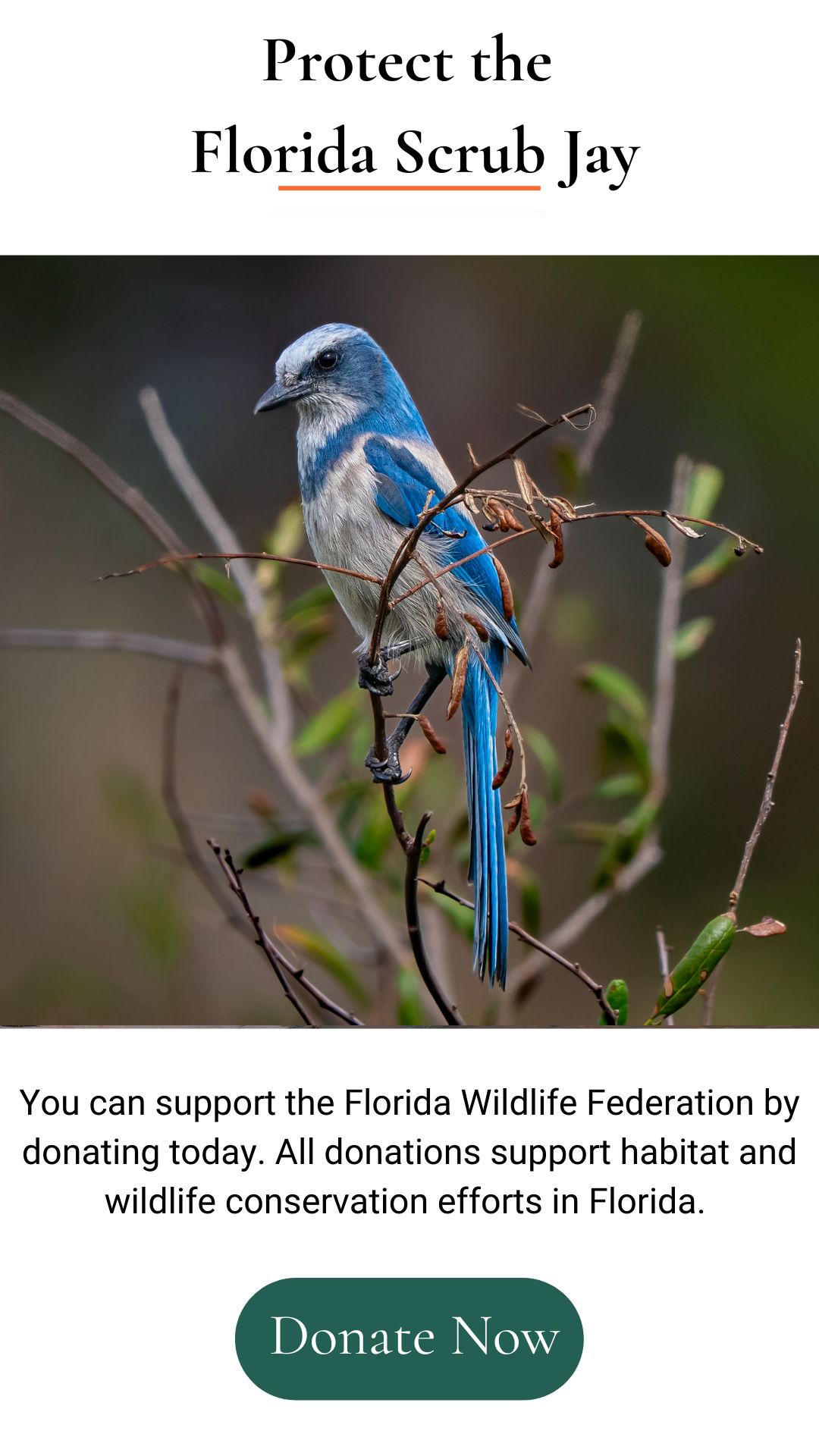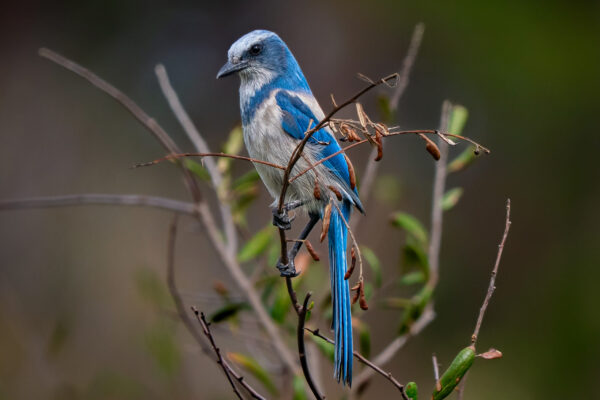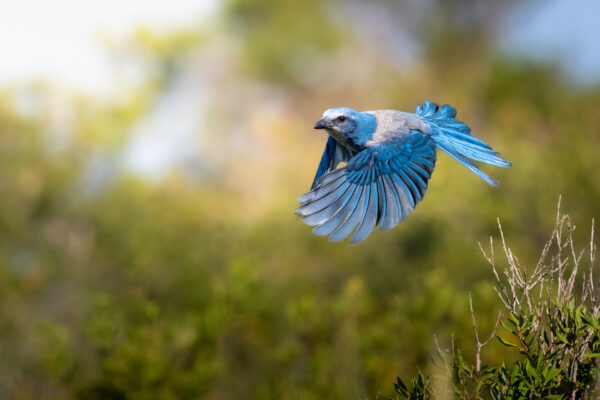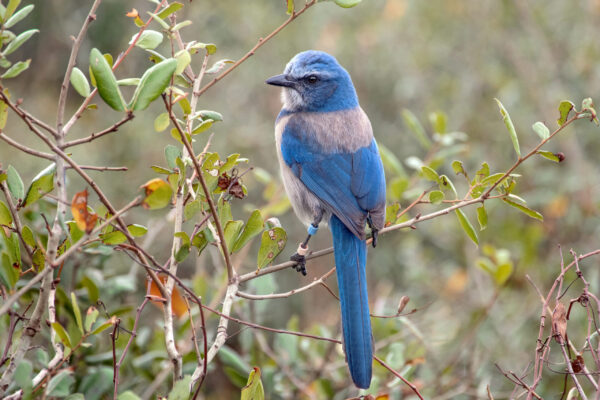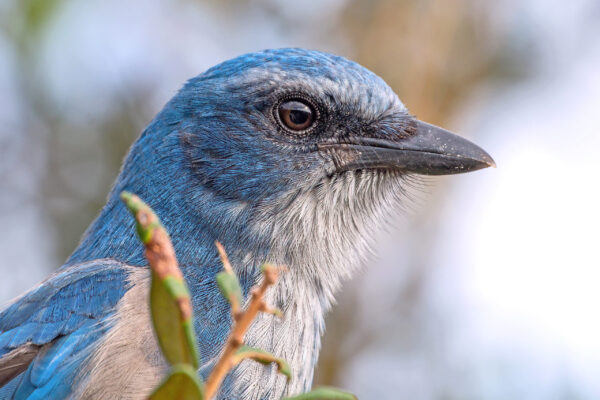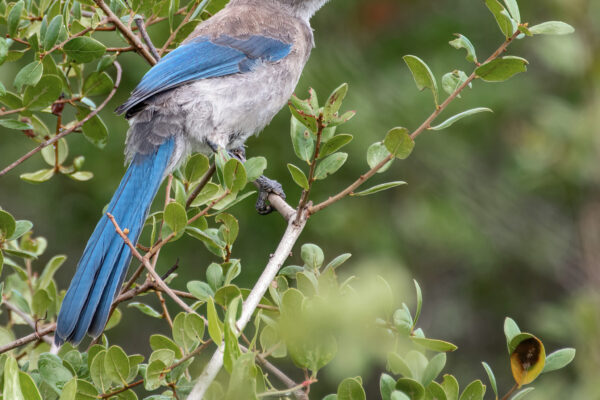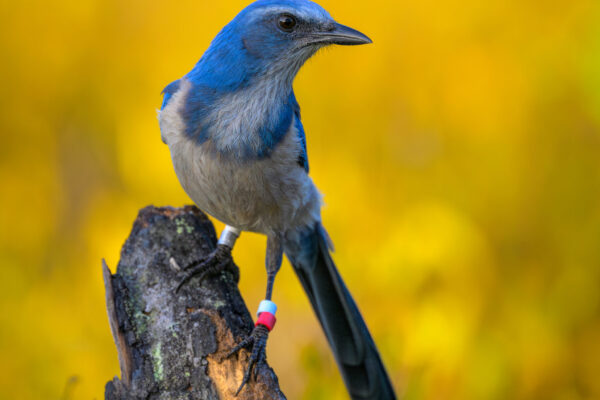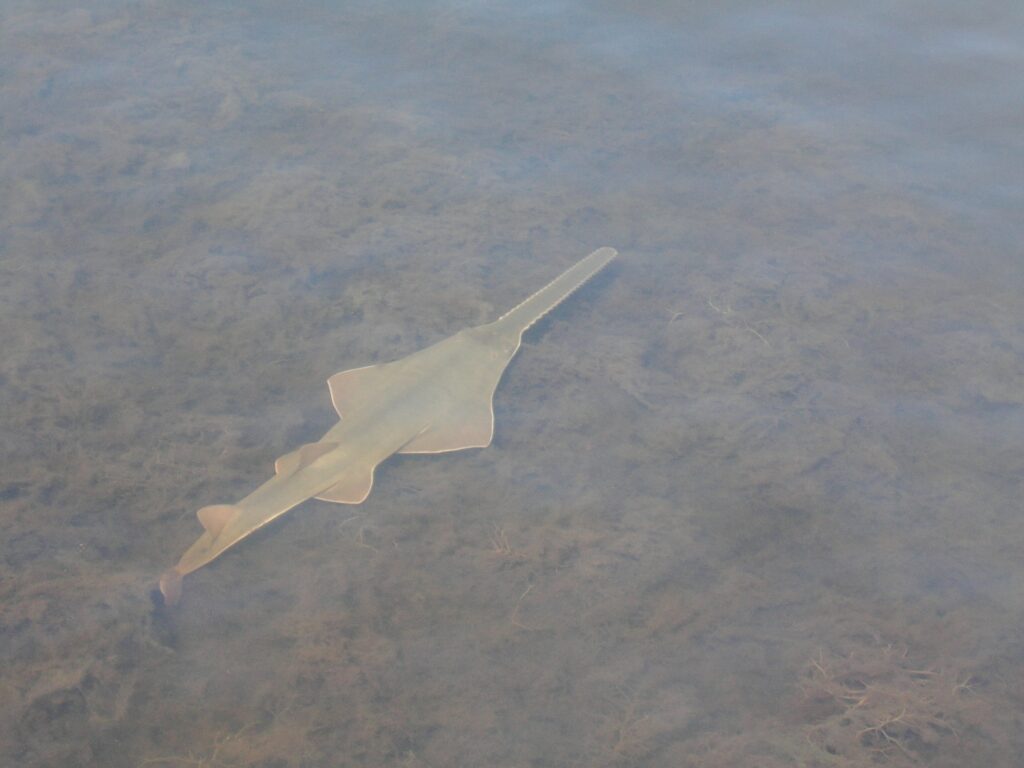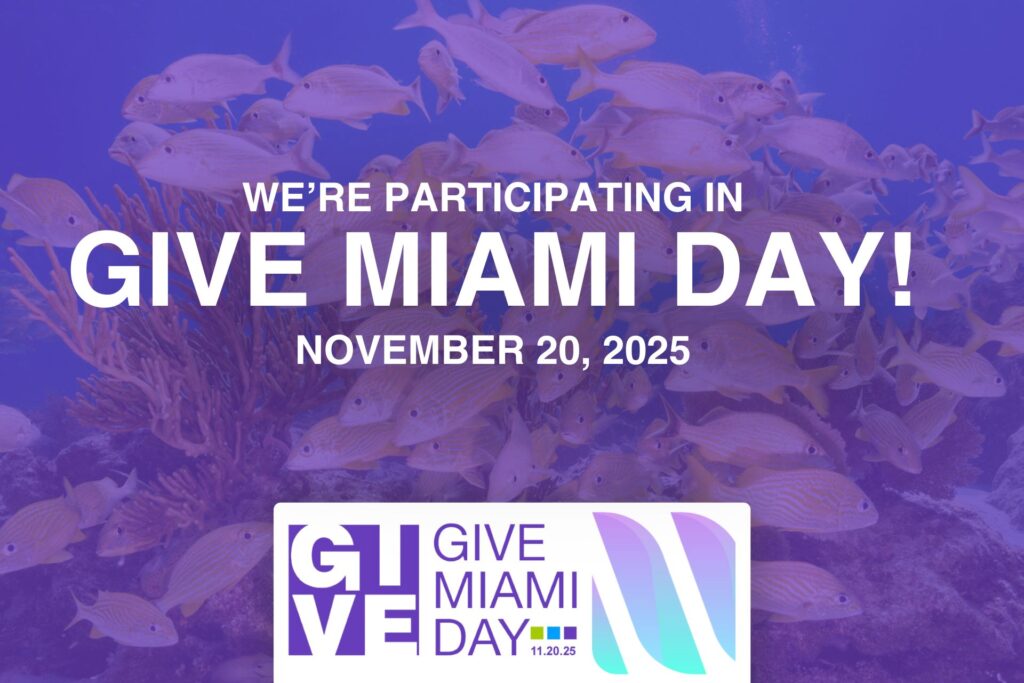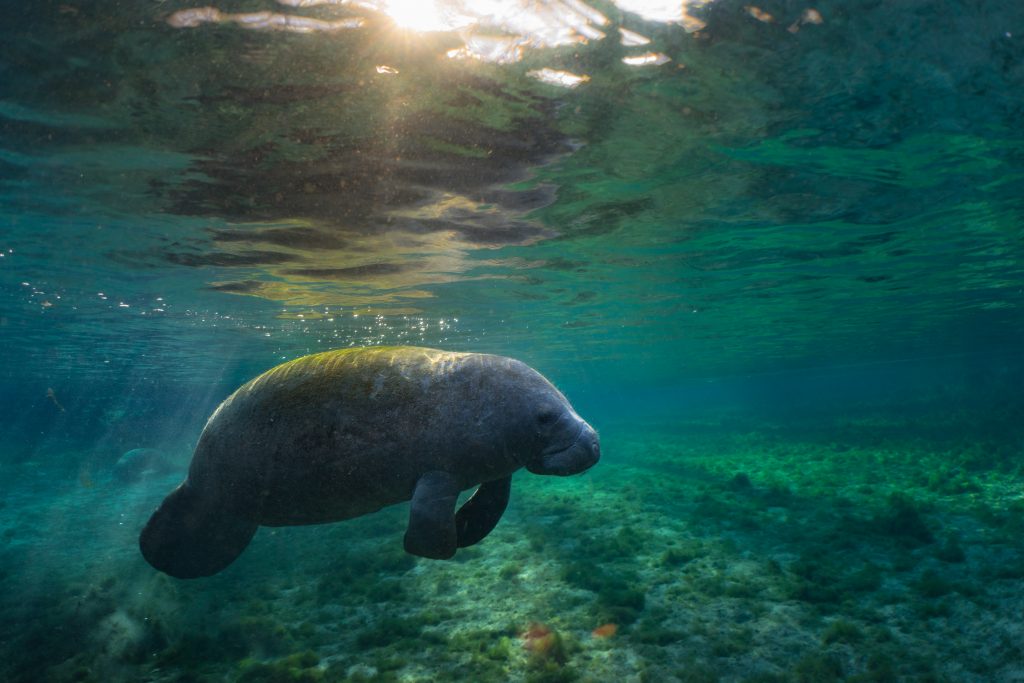The Florida scrub jay is one of Florida’s most unique native birds—and the only bird species endemic to the state. Found exclusively in rare scrub habitats, these striking blue and gray jays rely on healthy, fire-maintained landscapes to survive. The Florida Wildlife Federation is working to protect and restore the scrub ecosystems they call home, ensuring a future for scrub jays and the many other species that depend on this vanishing habitat.
The Florida Scrub Jay
Protecting the Florida Scrub Jay
The Florida scrub jay (Aphelocoma coerulescens) is the only bird species found exclusively in Florida, making it a true state treasure. These intelligent, social birds live in tightly knit family groups and are known for their cooperative breeding behavior. They depend on the state’s rare scrub habitats—characterized by sandy soils and low-growing oaks—which are increasingly threatened by development, habitat fragmentation, and fire suppression.
- Habitat: Florida scrub ecosystems, including oak scrub and scrubby flatwoods on well-drained sandy soils
- Population: Fewer than 10,000 individuals remain in the wild
- Conservation Status: Listed as “Threatened” under the Endangered Species Act
Today’s Challenges
Florida’s scrub jays face growing threats that jeopardize their survival and the future of the unique habitats they depend on. Decades of development, agriculture, and road construction have destroyed or fragmented much of Florida’s scrub, leaving populations isolated and vulnerable. Fire suppression has further degraded these habitats, as scrub jays rely on periodic burns to maintain the open, low-growing vegetation they need for nesting and foraging.
Because they are sedentary and highly territorial, scrub jays rarely move far from their birthplace, making it difficult for them to recolonize areas once the habitat is lost. Without continued conservation efforts—such as habitat restoration, prescribed burning, and protection of remaining scrub—these challenges will continue to push Florida’s only endemic bird toward extinction.
Conservation in Action
FWF is committed to conserving critical habitat for the Florida scrub-jay. By advocating for more land conservation funding and defending current safeguards, our work is to ensure these unique birds have the habitat to thrive.
In 2025, FWF joined Earthjustice and conservation partners in federal court to defend critical protections for the Florida Scrub-Jay. The motion seeks to intervene in a 2024 lawsuit filed in Florida’s Middle District by the Pacific Legal Foundation, which is challenging both Endangered Species Act safeguards and Charlotte County’s Scrub-Jay Habitat Conservation Plan — a framework that allows development in scrub habitats only when mitigation fees support habitat restoration and acquisition.
Represented alongside FWF are American Bird Conservancy, the Center for Biological Diversity, and the Environmental Confederation of Southwest Florida. Together, the groups are working to uphold federal protections for this iconic bird — and guard against a legal precedent that could undermine conservation efforts for numerous other species found only within a single state.
Learn About the Florida Scrub Jay
The Florida Scrub Jay (Aphelocoma coerulescens) is a medium-sized, crestless jay with bright blue plumage on its head, wings, and tail, and a soft gray back, nape, and underparts. The throat and forehead are pale, while the bill, legs, and feet are black. Adults typically measure around 10–12 inches in length, with a wingspan of 13–14 inches.
Unlike the more common blue jay, the Florida scrub jay has no crest and shows a cleaner color pattern. Juveniles have a brownish head and duller plumage, which changes to the striking blue and gray of adults within their first year.
Once widespread across Florida’s ancient scrub habitats, the Florida scrub jay has suffered severe population declines due to habitat loss, fragmentation, and degradation. Over 90% of Florida’s scrub habitat has been lost to development, agriculture, and fire suppression.
The species was listed as Threatened under the Endangered Species Act in 1987, granting it federal protections. Conservation measures have included habitat acquisition, prescribed burning to maintain suitable open scrub, and public education campaigns to reduce human disturbance.
Despite these efforts, scrub jay populations continue to decline, with fewer than 10,000 individuals remaining.
FWF Involvement:
In 2025, the Florida Wildlife Federation joined Earthjustice and other partners to defend the species’ ESA protections and Charlotte County’s habitat conservation plan from a legal challenge that threatened to weaken conservation safeguards.
Florida scrub jays face a combination of challenges that threaten their long-term survival. The most significant is habitat loss and fragmentation, as urban development, agriculture, and infrastructure projects have destroyed large portions of Florida’s scrub. Because scrub jays are sedentary and rarely disperse far from where they hatch, fragmented populations become isolated, reducing genetic diversity and making them more vulnerable to decline.
Fire suppression is another major concern—without periodic burns, scrub habitat becomes overgrown and unsuitable for nesting and foraging. Human disturbance, such as intentional feeding, can alter natural foraging behaviors and increase the risk of predation, while free-roaming cats and other predators pose direct threats to nests and young. Without continued habitat protection, restoration, and active management, these pressures will continue to push Florida’s only endemic bird closer to extinction.
Florida scrub jays are highly social and live in tight family groups. They are one of the few North American birds that practice cooperative breeding, where offspring from previous years, called “helpers”, stay with their parents to help raise younger siblings.
Pairs typically remain together for life and defend their territories year-round. Scrub jays are curious and intelligent, often approaching humans closely in areas where they have become accustomed to people. They communicate with a variety of calls, including harsh scolds, whistles, and soft notes used between family members.
Florida scrub jays are found only in Florida’s scrub ecosystems, which occur on ancient sandy ridges and coastal dunes. These habitats are dominated by low, shrubby oaks such as sand live oak, myrtle oak, and Chapman’s oak, with open sandy patches for caching acorns.
Because they avoid tall, closed-canopy forests, they depend on periodic wildfires—or prescribed burns—to keep vegetation low and open. They are most common in the Lake Wales Ridge, Ocala National Forest, Merritt Island National Wildlife Refuge, and scattered patches of scrub along the Atlantic Coast.
Florida scrub jays play an important role as seed dispersers, especially for oaks. Each fall, they collect and bury thousands of acorns in sandy soil to store for winter. Many of these acorns are never retrieved, allowing new oak seedlings to grow—helping maintain the scrub ecosystem.
They also feed on insects, spiders, lizards, small frogs, and other invertebrates, making them an important part of the food web. Their reliance on fire-maintained habitat links their survival directly to broader ecosystem management efforts in Florida’s scrublands.
Florida Scrub Jay (Aphelocoma coerulescens)
Kingdom: Animalia – Includes all animals, excluding plants and single-celled organisms.
Phylum: Chordata – Characterized by having a spinal cord.
Class: Aves – Birds.
Order: Passeriformes – Perching birds or songbirds.
Family: Corvidae – Jays, crows, and ravens.
Genus: Aphelocoma – A group of uncrested jays.
Species: coerulescens – From Latin for “bluish,” referring to its plumage.
Florida scrub jays are omnivores with a diet that changes seasonally. In fall and winter, acorns make up a large portion of their diet, supplemented by insects, small reptiles, fruits, and seeds during the warmer months.
Their acorn-caching behavior is critical to their survival during times when insects and other prey are scarce. The caching also benefits the ecosystem by promoting oak regeneration and maintaining healthy scrub habitat.
Florida scrub jays form long-term monogamous pairs, with breeding season typically running from March to June. Nests are built low in scrub oaks, constructed from twigs and lined with softer materials.
Cooperative breeding is central to their life history—helpers (often the previous year’s offspring) assist in feeding nestlings, defending territory, and mobbing predators. Clutches usually contain 2–5 eggs, which are incubated for about 18 days. Fledglings leave the nest around 18 days after hatching but remain dependent on the family group for several weeks.
Because scrub jays have low reproductive rates and strong site fidelity, loss of a territory or habitat patch can permanently eliminate a family group.
How to Help
Protecting the Florida scrub jay requires collective action to preserve and restore the rare scrub habitats it depends on, reduce human-related threats, and advocate for strong conservation policies. One of the most important efforts is maintaining and expanding fire-managed scrubland, ensuring these unique ecosystems remain open, healthy, and connected so scrub jay families can thrive.
You can help by:
- Donating to support conservation efforts: Your support allows the Florida Wildlife Federation to advocate for policies that protect and restore scrub habitats, defend Endangered Species Act protections for the Florida scrub jay, and work with partners to secure and manage critical lands.
- Educating your community: Spread awareness about the Florida scrub jay’s status as the only bird species endemic to Florida and the importance of fire-maintained scrub habitat. Encourage others not to feed wild scrub jays, as this can disrupt their natural behaviors and put them at greater risk from predators.
- Advocating for wildlife-friendly policies: Support land acquisition programs, habitat management funding, and science-based fire management practices that sustain scrub ecosystems. Urge decision-makers to protect connected habitat corridors and invest in restoration projects that will secure a future for the Florida scrub jay and the many other species that share its home.
Latest Wildlife News
Florida Scrub Jay FAQs
What does it mean that the Florida Scrub Jay is “endemic”?
“Endemic” means that a species is found naturally in only one specific geographic location and nowhere else in the world. The Florida Scrub Jay is endemic to Florida, making it a unique part of the state’s natural heritage and a high priority for conservation.
Do Florida scrub jays migrate?
No. They are highly sedentary and stay in their home territory year-round, rarely moving more than a few miles from where they were born.
Why do Florida scrub jays need prescribed burns in their habitat?
Fire is essential to maintaining the open, low-growing scrub vegetation that Florida scrub jays depend on for nesting, foraging, and acorn storage. Without periodic burns—either from natural wildfires or carefully managed prescribed fires—scrub habitats become overgrown, reducing food availability and making the area unsuitable for the species.
Are Florida scrub jays related to blue jays?
Yes. Both species belong to the corvid family (Corvidae), which also includes crows and ravens. However, Florida scrub jays lack the blue jay’s crest and are only found in Florida’s scrub habitats, while blue jays are common across much of North America.


